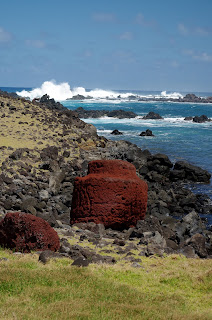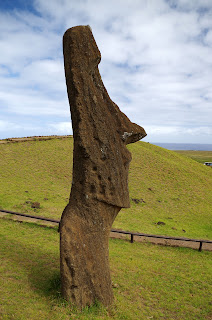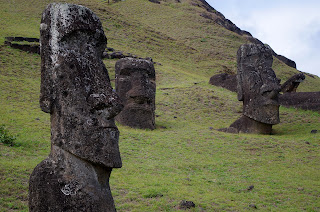The most iconic symbol of the Rapa Nui culture is the Moai statue. The enormous monoliths are still not completely understood but are believed to be tributes to the elders of older generations of the Rapa Nui people. The advent of the Moai mark the dawn of the incredible success of the people living on Easter Island, and the decline of the Moai signaled the decline of those people.
Tendering to the island was chaotic and difficult due to the fact that there is only one small harbor on Easter Island.
On the island, we’d booked an incredible villa that overlooked the ocean (we could actually watch the tenders coming to port).
And apparently, we were close to the airport too!
We began our exploration of the island driving the coastal road that passes by many of the historical sites.
The scenery was stunning, and the colors of the ocean were mesmerizing!
Many of the Moai sites that we initially visited revealed statues that had been toppled during conflicts. The people have decided to leave many of these sites in their current state because it reflects how waring tribes on the island would inflict damage to their enemies. Desecrating the Moai was not just considered a mortal insult, it was considered to be an actual assault on the lineage of a family because the Moai were thought to contain the Mana of the family.
One of the most interesting revelations about the Moai on Rapa Nui is that they were all carved from the same quarry. Archeologists have proven that all of the statues on the island were originally carved at the Rano Raraku volcano and then transported to their final resting place.
The number of statues at the quarry is impressive. There are 887 moai in total, and many of them represent different eras of Moai carving technique.
Near Rano Raraku is the largest ahu, or stone platform, of moai on Easter Island. Ahu Tongariki has 15 moai including an 86 tonne behemoth that holds the record for the heaviest moai ever erected. The site was toppled during tribal civil wars and was also damaged in 1960 by a large tsunami. However, archaeologists with the University of Chile restored the site in the 1990s.

After having driven over much of the island we made our way back to town to grab a bite to eat and watch the sunset. We didn't find any traditional cuisine in town, but who can say no to empanadas?
The evening was beautiful, but we were struck with a moment of dread and panic as we watched the Maasdam sail off into the sunset!
The next morning we awoke to the sound of the Maasdam's PA system as it began its tendering operation for the second day. Knowing that we had not missed our ride to Tahiti, we decided to drive to the top of Orongo, a massive volcanic caldera where the Tangata Manu, or Birdman, Competition was held. The winner of this competition became representative for the diety Make Make, and his group gained special privileges until the next yearly contest.
After spending the morning seemingly on top of the island we hopped back in the Jimny and headed North to the other side of the island.
One of the things that I like most about Easter Island is the rugged beauty. For obvious reasons, it reminds me of Iceland with all of its volcanic features. However, being in a tropical climate has seemingly increased the color saturation and everywhere we turned it felt as if the color dial had been pegged.
After reaching the far side of the island we explored the area that is thought of as the cradle of the Rapa Nui people. Anakena is thought to be where the first Polynesian settlers of Easter Island landed. It also happens to be one of the only sandy beaches on the island.
Before we knew it we had to turn in the Jimny and board the Maasdam. We felt like we barely scratched the surface of this amazing place, and we hope we can find our way to this remote outpost again!
Next up, Frech Polynesia!










































































